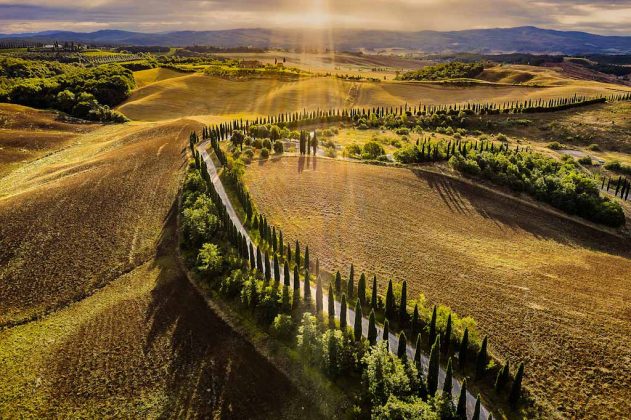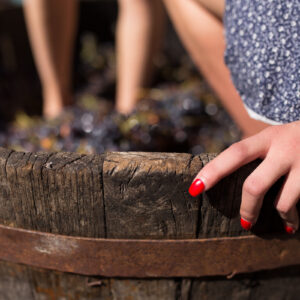Description
1.Antinori nel Chianti Classico
:max_bytes(150000):strip_icc():format(webp)/Antinori-d8583612e23c463bac420fcc9c7c61fc.jpg)
Though the Antinori family has been producing wines since 1385, their Antinori nel Chianti Classico winery smacks of modernity. Seemingly built into the landscape just outside Florence, the winery, which includes tasting rooms, wine bar, restaurant, wine museum, and shop were opened in 2013. Tastings include a tour that covers the history of the Antinori family, plus a sampling of three wines.
2. MonteRosola Winery
:max_bytes(150000):strip_icc():format(webp)/Monterosola-6585f217d33c4cc18f53ec06bf37bc48.png)
As one of Tuscany’s newest wineries, MonteRosola promises visitors a “wine experience” from start to finish. The avant-garde cantina, visitor’s center, and cellars opened in 2019—though they’ve been producing wine for several years—with a focus on sustainability and technology, albeit with respect to Tuscany’s centuries-long winemaking traditions. One of their signature wines, spicy, garnet-red Crescendo, is already garnering attention from wine critics.
3. Barone Ricasoli
:max_bytes(150000):strip_icc():format(webp)/Ricasoli-44bd792df82f4882aceb3f24fc3d5839.jpg)
Legendary is a word often used to describe Barone Ricasoli. Set near Gaiole in Chianti, the oldest winery in Italy is the alleged birthplace of Chianti wine, which only emerged in the late 1800s. The visitor experience here is a full-court press, with a wine shop open for walk-in tastings, to gardens, a thousand-year-old castle, winery tours, and more in-depth tastings. The high-end Osteria di Brolio restaurant is open from May to early November. Walk-in tastings include a garden visit while the Classic tour includes the castle, winery and cellars, followed by a private tasting.
4. Castello Banfi
:max_bytes(150000):strip_icc():format(webp)/La-Barriccaia---The-Barrell-Cellar-4e4e1c18a3564ac8a19bcff43f530ca8.jpg)
This isn’t just a winery—it’s a whole town. Located south of Siena, the winemaking village that surrounds Castello Banfi, a medieval fortress, includes Michelin-starred restaurant Sala dei Grappoli, a luxury boutique hotel, a glass museum, balsamic vinegar cellars, and a broad menu of winery tours. Two Tuscan heavy hitters—Brunello di Montalcino and Rosso di Montalcino—are produced at the Castello. The entry-level Banfi Tour includes a visit to the balsamic vinegar cellar, the vineyards, and the winery, plus an aperitif at the wine shop and a tasting of three Castello Banfi wines.
5. Avignonesi
Set near the border with Umbria, venerable winery Avignonesi dates to the 1500s but converted to organic, biodynamic farming in 2009. Its sweet Vin Santo and robust Vino Nobile di Montepulciano are among its best-known wines. The Tour and Taste visit includes a tour of two vineyards and a lesson in biodynamic winemaking, followed by four tastings. Tasting tours including a gourmet lunch are also popular.
6. Capo d’Uomo
:max_bytes(150000):strip_icc():format(webp)/CapodUomovineyard-5799f81e1c8340e184a71e85cbd9a50e.jpg)
Climbing precipitously above the Tyrrhenian Sea on Tuscany’s Argentario promontory, small-scale winery Capo d’Uomo has long been held by the Grimaldi family and is famous for its one-of-a-kind wines, including Maisto, Rosso di Capo d’Uomo, Africo, Bianco di Capo d’Uomo, Pinkus, and Duncan. Olive oil, artichokes, and tomatoes are also produced on the estate, and there’s a sea-view villa for rent, as well as simpler cantina accommodations. The wine shop is open most days but definitely call ahead to book a visit here.
7. Col d’Orcia
:max_bytes(150000):strip_icc():format(webp)/Vigneti_4-2461dcc5ff0b4ad8855cb2979160ecbd.jpg)
Despite being the largest organic winery in Tuscany, Col d’Orcia retains an old-school, family feel that has endeared it to countless visitors. The affordably-priced tastings include a tour of the organic farm, a cellar visit, and a guided tasting of three wines, including their famous Brunello di Montalcino. The winery is located southeast of the town of Montalcino.
8. Tenute Ruffino-Poggio Casciano
:max_bytes(150000):strip_icc():format(webp)/RuffinoPoggioCasciano-ca65ea1c93774ba090f3ac87469a4a01.jpg)
If you’ve ever had a bottle of Chianti in the US, chances are good that it was from Ruffino, one of the largest producers and exporters of Chianti. While the vintner has wine estates across Tuscany and the rest of Italy and produces dozens of wines, its main visitor center is at Poggio Casciano, a 1300s villa not far from Florence. A dramatic tunnel lined with wine barrels is the highlight of tours here. Tasting tours include a tour of the grounds, the villa halls, and the aforementioned tunnel, with tastings along the way. Appointments are a must.
9. Fattoria La Loggia
:max_bytes(150000):strip_icc():format(webp)/FattorialaLoggia-2bfd379e39744a598a31ce05ed1fe986.jpg)
In a Tuscan-dream-come-true setting that combines, wine, food, and a significant modern art collection, Fattoria La Loggia occupies a 15th-century estate once owned by the Medicis. The estate is as much about hospitality as it is about wine, but its Super-Tuscan blend is noteworthy. Call to arrange a tasting accompanied by bruschetta and farm-made olive oil, a tasting with lunch, or an overnight. Soaring views of the Chianti hills are included.
10. Villa Pomona
Monica Raspi took over her family vineyard in 2007, and her labor of love is evident everywhere at Villa Pomona. Set in the Chianti Classico area near Castellina, Villa Pomona produces high-quality Chiantis, as well as other Sangiovese-based reds and a few white wines. A rustic, friendly vibe pervades in this all-organic winery, which also produces olive oil and has two guesthouses on the grounds. Call ahead to schedule a visit.
11. Tenuta Sanoner
:max_bytes(150000):strip_icc():format(webp)/TenutaSanonerwinery-3ebad3cc2667404f9f925cbf9cb28132.jpg)
Still a relative newcomer on the Tuscany wine map, Tenuta Sanoner has been producing organic, biodynamically grown wine since 2016. Its architecturally stunning and state-of-the-art winery and tasting room blends with the Tuscan landscape. The majority of wines produced here are 100 percent Sangiovese reds, but Sanoner also makes a rose and a few sparkling wines. The winery is affiliated with ADLER Spa Resort Thermae, a luxury thermal spa hotel just down the hill in Bagno Vignoni.
12. Montenidoli
:max_bytes(150000):strip_icc():format(webp)/Montinidolivines-6252bbdee8014312bf9baaad5cd26b4a.jpeg)
In a region known for its hearty red wines, Montenidoli stands out as a top producer of Vernaccia di San Gimignano, the aromatic white associated with the town of San Gimignano, a favorite stop on many a tour of Tuscany. This family-held winery also produces a stellar rosé, and visits to this earthy, lovingly cared-for estate rank among the top wine experiences in the area. Book ahead for a casual walk through the vineyards and a guided tasting.
13. Castello di Nippozano/Frescobaldi
:max_bytes(150000):strip_icc():format(webp)/CastelloNippozani-5e55f16cef7d46bd9ca2f77cd85a6799.jpg)
Just east of Florence, Castello di Nippozano has been producing wines since at least the Renaissance, when Donatello was apparently a loyal customer. Today, the imposing 11th-century castle is part of the Frescobaldi wine dynasty—the storied Florentine family has been producing wine since the 1300s. Their Chianti Classico Riserva and Mormoreto are signature wines, but as many visitors come for the castle perched high on the edge of the Tuscan Appennines. Wine tours are customizable and must be booked ahead.
14. Tenuta Ripalte Elba
:max_bytes(150000):strip_icc():format(webp)/TenutaRipalte-a31c585f019844c68e8f20aa8d333c50.jpg)
Aleatico grapes are grown throughout Italy but they’re most closely associated with Elba, the largest island of the Tuscany archipelago and the site of Napoleon’s short-lived exile. It’s a signature wine of Elba’s Tenuta Ripalte, located on the island’s rugged southeastern promontory, along with sweet, strong Passito, and lighter Vermentino and Rosato. Tours include a visit to the dramatically sited vineyard, plus tastings on the equally enchanting outdoor terrace.
15. Fontuccia
:max_bytes(150000):strip_icc():format(webp)/FontucciaGiglio-59f041baa46b4655bc43651099f1cb7b.jpg)
Scrappy, low-lying Ansonaco grapes thrive in the Isola di Giglio‘s dry, rocky, windswept climate, and produce both dry Ansonaco table wines and sweet Passito dessert wines. To see these hearty vines in their element, make an appointment for a tour and tasting at Fontuccia, or contact Visit Giglio Island to book a wine and food experience on the island.
16. Fontodi
17. Castello di Verrazzano
18. Castello di Vicchiomaggio
19. Castello di Vignamaggio
20. Frescobaldi




